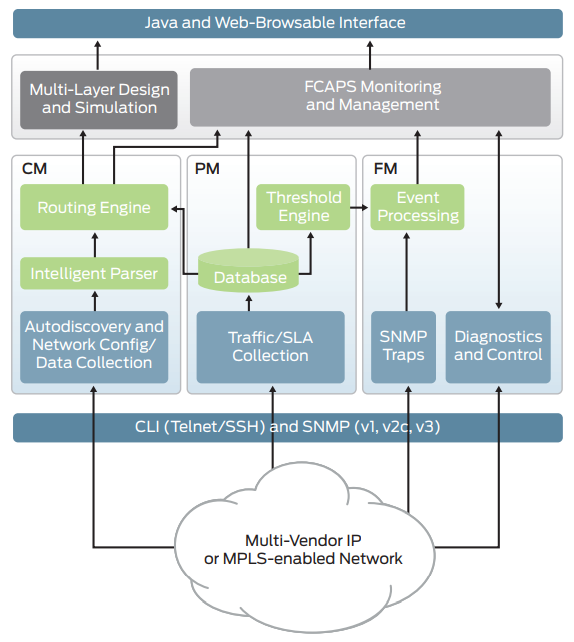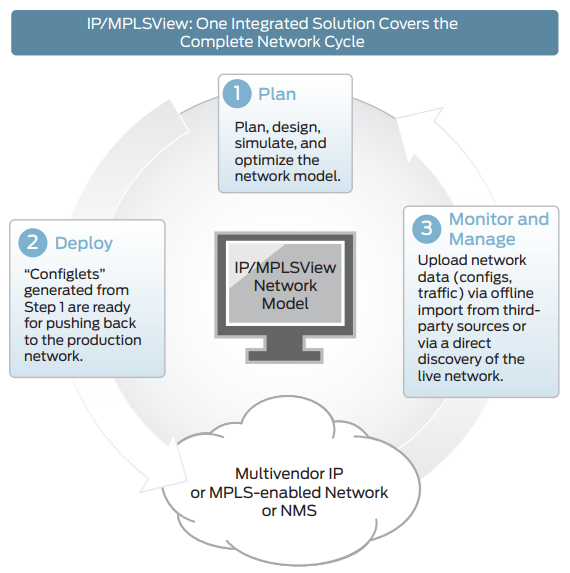
Juniper Networks WANDL IP/MPLSView
IP/MPLS traffic management and engineering solution
Our Price: Request a Quote
Our Price: Request a Quote
Our Price: Request a Quote
Our Price: Request a Quote
Click here to jump to more pricing!
Please Note: All prices displayed are Ex-VAT. 20% VAT is added during the checkout process.
Overview:
Service providers can no longer afford a reactive and overbuilt network to handle traffic growth from emerging services. Instead, they need an approach that first optimizes their existing network assets and then ensures that every bit in the network leads to a dollar of revenue being generated.
IP/MPLSView is a multivendor, multiprotocol, and multilayer operations support systems (OSS) traffic management and engineering solution for IP and/ or MPLS networks. With IP/ MPLSView, service providers can increase overall network utilization with a platform that provides multivendor integration, unprecedented scalability, and powerful fault management capabilities.
Product Description
Juniper Networks WANDL IP/MPLSView is distinguished by its attention to detailed routing protocol behavior, an extensive multivendor library, and scalability and performance for networks up to thousands of routers. The integrated software suite has traffic engineering models for exhaustive single and concurrent device failures, traffic matrix estimation, MPLS diverse path design, fast reroute design, network optimization, and more. Additionally, the IP/MPLSView integrated network management module provides a comprehensive fault, configuration, accounting, performance, and security (FCAPS) solution offering automated network discovery, traffic monitoring, hardware inventory, and fault management tools.
As a multivendor, multiprotocol, and multilayer management suite, IP/MPLSView offers service providers the following benefits:
- One single platform that provides integrated online FCAPS management
- Multivendor integration for fast network autodiscovery
- Unprecedented scalability to handle regional, national, and intercontinental network topologies
- Performance management to tune the network for increased efficiency, trending analysis, and problem prevention
- Powerful conformance checking to ensure compliance and address any configuration management needs
- Powerful fault management tools to quickly detect and diagnose issues in the network
IP/MPLSView combines FCAPS management in a single modular platform. Coupled with complete physical and logical views of the network, network planners, designers, engineers, and operators can now make intelligent and informed real-time decisions regarding the network’s operation and performance.
As a highly intelligent and automated system, IP/MPLSView also provides a continually refined design and algorithm optimization that reflects industry best practices and years of customer interactions. IP/MPLSView addresses the major areas of network planning, including traffic and routing analysis, capacity planning, resiliency analysis/disaster planning, path design, and optimization. In addition, an intuitive interface allows users of varying levels to use the system effectively without having to program or develop a model first.

Figure 1: IP/MPLSView supports a multivendor/multiprotocol IP or MPLS network
Architecture and Key Components:
IP/MPLSView is made up of three suites: Design and Planning, Management and Monitoring, and Service Creation and Provisioning. These three suites support the complete network cycle and handle the varying needs of network designers, planners, operators, and managers. Understanding IP/ MPLSView’s integrated workflow provides an in-depth look at the product’s comprehensive capabilities, which include advanced OSS functionality that give users visibility into the network layers from physical transport through logical service layers. As a multivendor, multiprotocol, and multilayer solution, IP/MPLSView supports the following goals and network planning requirements:
- Automate network topology construction
- Perform traffic load analysis
- Perform capacity planning
- Ensure network resiliency against failure
- Identify and prevent potential bottlenecks
- Automate low cost, robust network designs
- Validate changes prior to deployment
- Design and simulate MPLS-TE networks
- Create and model VPNs
- Model the VLAN network
- Model and analyze BGP
- Analyze CoS to meet SLAs
- Simulate multicast
Automatic Network Topology Construction
From a set of network configuration files and other optional data, an intelligent multivendor analyzer within IP/MPLSView immediately constructs an accurate network topology, fully aware of multiple protocols, layers, autonomous systems (AS), areas, VPNS, etc. This network data can be imported into the tool or collected directly by the system itself if used in conjunction with the IP/MPLSView network management online module. Alternatively, the user can manually construct any network topology via the IP/MPLSView advanced graphical interface.
Perform Traffic Load Analysis
With IP/MPLSView, users can access current and historical traffic charts to pinpoint bottlenecks or underutilized links at-a-glance from the topology map. For loading traffic into the network model, IP/MPLSView offers its own traffic collection utilities, as well as support for utilities that import traffic from third-party sources such as MRTG, NetFlow, eHealth, and InfoVista. If you do not know the end-to-end traffic matrix, IP/MPLSView is able to derive it from the interface traffic using intelligent tomography models in the traffic matrix solver module.
Perform Capacity Planning
IP/MPLSView facilitates decisions about future network expansion by studying the impact of adding new demands before they are placed on the real network. Planners can use the system to determine whether there is sufficient available capacity or where more should be added, as well as which links can be pruned without compromising resiliency requirements.
Ensure Network Resiliency Against Failure
With IP/MPLSView, users can study the impact of extensive node, link, site, card, and Shared Risk Link Group (SRLG) multilayer failure scenarios. They can also analyze the way traffic is rerouted and the effect on network links (e.g., worst-case trunk utilization), and even perform exhaustive single, double, and triple failure tests.
Identify and Prevent Potential Bottlenecks
IP/MPLSView provides insights as to why traffic flows or tunnels fail to route and helps identify which trucks become congested under certain failures or what-if scenarios.
Automate Low Cost, Robust Network Designs
IP/MPLSView automatically determines where to add links to satisfy traffic for resiliency against any failure scenario. A network can be designed from scratch or on top of an existing network configuration. Tariff or pricing data can be imported for least cost topology designs.
Validate Changes Prior to Deployment
IP/MPLSView allows the network planner to validate day-to-day network changes, or model and simulate network migration, network expansion, or the merging of multiple networks. This provides the ability to analyze the impact of these changes in a safe, virtual environment, and also experiment with changing parameters, protocols, topology, and so on.

Figure 2: One integrated solution covers the complete network cycle.
Design and Simulate MPLS-TE, LSP Routing
With IP/MPLSView, users can design and simulate LSP tunnels via intelligent MPLS LSP path calculation. They can perform network outage simulations across both MPLS and IP layers. automate MPLS fast reroute (FRR) backup tunnel design and simulation, automate the design of diverse paths for primary and backup protection tunnels, and optimize LSP paths that have become suboptimal over time.
Create and Model VPNs
IP/MPLSView lets users model a wide variety of VPNs and perform VPN routing simulation. You can use the system to generate VPN traffic and then perform card failure simulation to see if a VPN will be brought down by a single card failure. You can also run VPN-specific integrity checks on the configuration files.
Model the VLAN Network
IP/MPLSView shows you topology, status, and details for each VLAN, spanning tree, and device. It is easy to model the VLAN network by using the VLAN Wizard to construct or modify VLANs.
Model and Analyze BGP
With IP/MPLSView functionality, users can study BGP routing, perform detailed BGP routing analysis and what-if studies involving BGP policy changes or the addition of new BGP peers, and perform detailed BGP neighbor analysis.
Analyze CoS to Meet SLAs
To ensure that they are meeting service-level agreements (SLAs), service providers can use IP/MPLSView to model class of service (CoS) classes and policies, as well as different queuing schemes. They can also define application flows based on CoS, which enables the modeling of voice over IP (VoIP) or video on demand (VOD). IP/MPLSView also helps analyze packet loss and delay statistics per class of service.
Simulate Multicast
With IP/MPLSView, users can simulate multicast flows based on user-defined multicast groups and demands. They can also simulate the effect of rendezvous point selection on the distribution tree and on link utilization, as well as shortest-path tree (SPT) switchover.
Features and Benefits:
- Reduce network costs: Effective designs can result in lower hardware and maintenance costs. Juniper Networks IP/ MPLSView features tariff-based design, MPLS LSP traffic engineering for effective utilization of the network, and superior design optimization.
- Automate for productivity and operational efficiencies: With the state-of-the-art IP/MPLSView design engine and heuristics, tasks such as report, topology map, and LSP path generation are automated, as well as tasks such as accommodating traffic growth and optimizing the backbone topology.
- Guard against unnecessary risk: Assessing the network using IP/MPLSView’s intelligent integrity checking, resiliency analysis, fiber cut analysis, etc., helps operators avoid problems and mitigate risk.
- Diagnose performance problems: Using IP/MPLSView’s flow analysis, bottleneck detection and analysis, peak utilization analysis, discrete event simulation, and multicast simulation helps administrators quickly diagnose performance problems.
- Validate changes prior to deployment: IP/MPLSView enables designers and administrators to validate new services, new equipment, and new technologies before they are rolled out.
- Plan for future growth: Using IP/MPLSView’s superior capacity planning and data forecasting helps inform and optimize plans for growing the network to meet business needs.
Specifications:
Recommended System Configuration
IP/MPLSView runs on a client/server architecture. The recommended configuration depends upon the size of the network and the number of users. Sample client/server configurations are listed below. For a more precise hardware estimate for your network, please contact your local Juniper representative.
Main Application Server
- Multi-core CPUs with clock speed greater than 2.5GHz
- 8 GB for a single application server
- CentOS and RedHat 6.6 to 7.0
- 100+GB server disk space
Java Client (PC)
- Windows 7/8/10
- 4 GB RAM or more
Documentation:
Download the Juniper Networks WANDL IP/MPLSView Data Sheet (PDF).
Pricing Notes:
- All prices displayed are Ex-VAT. 20% VAT is added during the checkout process.
- Pricing and product availability subject to change without notice.
Our Price: Request a Quote
Our Price: Request a Quote
Our Price: Request a Quote
Our Price: Request a Quote
